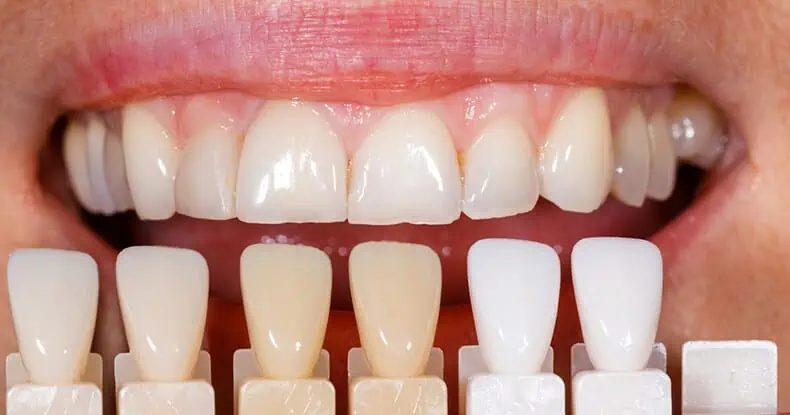Are you considering asking your dentist about dental bonding? Maybe you have a cracked tooth, or even want to change the way your smile looks. No matter what the reason is, we at Dentaly.org want to make sure you have all the information you need regarding cosmetic procedures like dental (or tooth) bonding. That way you can make informed decisions on what procedure you think best fits your needs.
In this article we are going to cover the most important questions regarding dental bonding, such as:
- What is dental bonding?
- How long does the procedure take?
- How much can it cost?
- Are there alternatives to dental bonding?
- What are the risks or disadvantages of tooth bonding?
By answering these questions we hope to give you an idea of whether or not a tooth bonding procedure is right for you. That said, you should always consult your dentist about the potential benefits and risks of any dental work before committing to an appointment or using any at-home dental kits.
Before we get into what dental bonding is and how the procedure is performed, let’s take a look at what types of problems it can fix and what makes someone a likely candidate for tooth bonding.
Why might someone want dental bonding?
Tooth bonding (sometimes called composite resin bonding) is a cosmetic technique to improve the aesthetic of your smile, though it isn’t a solution to any medical or structural issues in your teeth. There are, however, a few issues that it can address. These include:


- Diastema (gaps between teeth)
- Cracked or chipped teeth
- Discolored teeth
- Teeth that are crooked or misshapen
Essentially, composite bonding is meant to even out the size, shape, or color of teeth or cover any minor issues in someone’s smile.
What is tooth bonding?
“Bonding” is often used to mean adhesives in dental work. But “dental bonding” or “tooth bonding” on their own refer to changing the appearance of someone’s smile for cosmetic purposes. According to the ADA, dental (or cosmetic) bonding is a procedure dentists use to make cosmetic changes to your smile.
Usually focused on the front teeth, dentists use a composite resin similar to what they use for minor fillings. This material is a putty-like substance that can be molded to a desired shape, then hardened and polished to closely resemble a natural tooth.
A dentist will first try to match the color of their composite resin to the patient’s natural teeth. They prepare the surface of the teeth, apply a layer of adhesive material, and finally apply the resin, which the dentist forms into the desired final shape of the tooth.
Once the dentist is happy with the way the composite resin is shaped, the dentist will use a powerful UV light to quickly harden the material. Finishing touches include buffing out rough or uneven spots and ultimately polishing the resin so it matches the rest of the patient’s teeth. Once the resin is properly hardened and polished, the patient is free to go home and resume their regular eating and drinking habits.
Cosmetic resin teeth bonding video
If you want a visual example of how teeth bonding for gaps is performed, you can watch the video below. It’s a bit long but gives a great step-by-step look at the entire process, with before and after comparisons to show the effect dental bonding can have on your teeth.
How long does bonding teeth take?
Generally, a dentist will need anywhere from 30 to 60 minutes per tooth to ensure that the adhesion, shaping, and finishing of the composite resin is all done properly. Where your procedure falls in that range will depend on your dentist’s experience, efficiency, and attention to detail. Not all tooth bonding procedures are created equal. Some people use dental bonding to improve the look of a single mismatched tooth, while others will totally revamp the shape and spacing of their smile.
How long does tooth bonding last?
Teeth bonding lasts an average of five to ten years before it must be replaced, but there are different factors involved. First of all, different types of composite resin have different properties. More durable resins don’t look quite like natural teeth and so are generally used farther back in the mouth. If your dental bonding is for front teeth, it’s likely that your dentist has chosen a resin that more closely resembles natural teeth but is not quite as hard.


Here’s a short list of ways you can care for your bonded teeth and hopefully get a few more years out of them:
- Proper oral hygiene: Tooth decay can cause resin to lose its adhesion to your teeth. With or without bonding, brushing your teeth and flossing properly are still the best way to keep your smile looking great!
- Avoid hard foods/chewing ice: Composite resin is not as durable as teeth, so the same habits that wear down teeth will degrade your dental work even faster.
- Try not to grind your teeth: Though for some it’s easier said than done, by reducing stress or saying no to that third cup of coffee you can significantly reduce damage to your bonded teeth over time.
- Don’t whiten: Even though it may not be at the same rate, composite resin and natural teeth will stain together. The difference only becomes very noticeable after whitening, which will work on natural teeth and not on bonded teeth!
Getting dental bonding is a perfect reason to try and break some bad habits. With proper care and cleaning, bonded teeth can maintain their strength and natural look for years!
How much does dental bonding cost?
It shouldn’t surprise you that just like durability, teeth bonding prices can vary greatly from patient to patient. The cost is affected primarily by the number of teeth involved. It can run anywhere from $250 to $600 on average and even up to $1,200.
Before scheduling an appointment for dental bonding, you should always consult your dentist to learn how much they will charge you. It’s also a good idea to find out if the procedure will be covered by your insurance, as that can significantly reduce the out-of-pocket cost to you.
Are there at-home tooth bonding kits?
There are several different kits for teeth bonding at home, but they have quite a few disadvantages. First of all, at-home teeth bonding kits are really only meant for the most minor of cases. You wouldn’t be able to do anything more advanced like filling gaps between your teeth.
Beyond that, at home you simply won’t have the tools that a dentist uses to achieve a strong bond and natural look. A dentist will choose among several composite resins to best fit your needs, and will make use of picks, mirrors, and some motorized tools to give a result that is indistinguishable from natural teeth.
Ultimately, although you can maybe save money on a minor procedure with dental bonding at home, you will almost certainly get a better-looking and longer-lasting result from a dentist.
Are there alternatives to tooth bonding?
Tooth bonding is not the only way to cosmetically alter the shape of a tooth, or even your whole smile. Dental bonding can mask damage or decay, but more severe cases will more often call for a crown. Your dentist will know when this is necessary.
With regards to purely cosmetic bonding, porcelain veneers offer a popular alternative to composite resin, both offering certain advantages over the other. So, let’s take a closer look.
Have a look at this table for a quick comparison of porcelain veneers and dental bonding treatments:
Composite resin bonding | Porcelain veneers | |
Cost | $250–$1,200 | $500–$2,500 |
Number of appointments needed | Usually 1 | 2 to 3 |
Longevity | 5–10 years; susceptible to staining | 10–20 years; color stable |
Other considerations | Enamel removal is very rare and almost always reversible | Almost always require enamel removal; cannot be reversed |
Porcelain veneers have a few major benefits over composite resin bonding. First, they are more durable and can be expected to last up to twice as long as dental bonding. On top of their durability, they are also much more color-stable, so staining is less of a concern over time. They also tend to have a more natural look without having to sacrifice longevity.


However, you can pay up to twice as much per tooth. You will also have to invest more time because veneers must be made in advance, requiring several appointments before they are actually installed.
Most importantly, composite resin can be removed in the future, and the process can usually be fully reversed. To place porcelain veneers, a dentist will almost always need to remove enamel from your teeth. Though the final product is functionally as good as a natural tooth, you won’t be able to restore your original smile to the way it was.
Dental bonding near me
If you think you’d benefit from dental bonding, the next step is to set up a consultation with a dentist who offers dental bonding services.
To find dental bonding near you, you can call 866-383-0748. You’ll speak with a live operator who will connect you with a dentist who offers dental bonding near you.
Conclusion
Tooth bonding is a low-risk and relatively inexpensive cosmetic procedure that can significantly change the look of a single tooth or your whole smile. It involves shaping composite resin to your teeth, followed by hardening and polishing for a natural finish. Though there are some kits designed to let you perform minor repairs at home, a dentist will give you much better results, as they have the proper tools and much more experience.
The cost and time investment associated with this procedure vary from patient to patient, but generally it can be completed with a single visit to the dentist. Depending on the way you care for your dental work, tooth bonding can last anywhere from 5 to 15 years.
The main alternative to bonding is porcelain veneers, which are fabricated in advance and attached to your teeth. This is a more expensive and time-consuming procedure but gives longer-lasting and more stable color results.
FAQs
How do I whiten bonded teeth at home?
Unfortunately, you can’t. Because composite resin is a fairly porous material once it’s hardened, it is very susceptible to intrinsic staining. Extrinsic staining can be whitened. But intrinsic staining is almost impossible to remove in bonded teeth. The effect of whitening in this situation is a noticeable difference in the color of your tooth versus the composite material.
Can a dentist whiten my composite resin fillings and teeth?
Just as you can’t whiten dental work at home, neither can a dentist. However, a dentist can apply a thin layer of resin to even out the color of your teeth, and make them appear whiter. But if you are a frequent smoker or drink a lot of coffee and red wine and continue to whiten, the problem will return.
How long do I have to wait before eating with bonded front teeth?
Fortunately, dental bonding doesn’t require a recovery period. Alhough you may want to wait a few days before returning to habits that can stain teeth like smoking or drinking coffee.
ADA: Bonding. Consulted 23 October, 2020.




